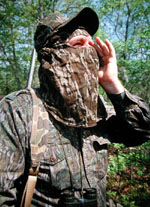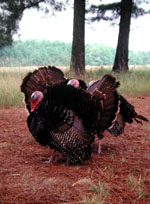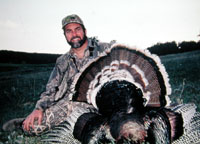
|
Features
|
|
|
|
Books
|
|
|
|
Fun & Games
|
|
|
|
Contact Us
|
|
|
John's Journal... Entry 141, Day 5
MASTERING TURKEY TALK WITH WILBUR PRIMOS
Cutting, The Wavy Call and The Purr
 EDITOR'S
NOTE: Turkey hunters understand the basic language of turkeys, but
perhaps not the subtleties of that language. Often the subtle variations
in the volume, rhythm and pitch of a turkey's call mean just as much as
the kind of call it is. Sometimes these variations may mean even more.
The most skillful turkey hunters -- the masters of the sport -- know how
to add these subtleties to their calling. This week, avid deer and turkey
hunter, Wilbur Primos of Jackson, Mississippi, the founder of Primos Game
Calls, will share some of his secrets to use turkey talk effectively to
attract even the most stubborn birds.
EDITOR'S
NOTE: Turkey hunters understand the basic language of turkeys, but
perhaps not the subtleties of that language. Often the subtle variations
in the volume, rhythm and pitch of a turkey's call mean just as much as
the kind of call it is. Sometimes these variations may mean even more.
The most skillful turkey hunters -- the masters of the sport -- know how
to add these subtleties to their calling. This week, avid deer and turkey
hunter, Wilbur Primos of Jackson, Mississippi, the founder of Primos Game
Calls, will share some of his secrets to use turkey talk effectively to
attract even the most stubborn birds.
Cutting:
Cutting is what the northern boys have decided to call what hunters in
the South have always considered to be excited clucking. The call is still
the same. Those Yankee hunters just decided to give it a newer and classier
name. Cutting is a series of fast, excited clucks put together to show
another degree of a hen's excitement. The best way to explain what cutting
means to an old gobbler is to relate it to what can happen at a bar. A
man sits on a stool beside a woman he's trying to pick up, and suddenly
she gets excited. That's the reason cutting is such a deadly call to use
for an older gobbler.
 The
Wavy Call:
The
Wavy Call:
This is another call that's often overlooked by hunters. I use the term
wavy because the pitch changes as the call is given, starting on the crest
of a wave and then sliding down the side and climbing halfway up the side
of the next wave. A hen gives this call when she's extremely content --
when the sun is shining on a spring or a fall day and she's out in the
middle of a field, far from danger, chasing crickets or grasshoppers,
just happy to be alive. It's a feeding call, and the sound is sort of
"Pee-uuuu." I'll use this call with the basic yelps when I'm trying to
act unconcerned about a gobbler. I want him to think I could care less
whether he comes over to where I am. Then he'll decide he has to influence
me and show me just what a fine gobbler he really is, so I'll get excited
and be ready to mate with him. When the tom comes over to impress me,
that's when I'll take him.
 The
Purr:
The
Purr:
The purr is another contented call of the hen. She doesn't think, "Now
I'm going to give a purr," but instead just gives it when she's happy.
She's really not conscious of giving the purr. The purr may compare best
to a woman's humming. She's not humming because she means anything by
it. She's just happy with her situation and her surroundings, and humming
is the best way to express her contentment. Many times, you can use the
purr early in the morning to communicate to a gobbler that a hen is contented
and has no intention of mating. This call will often cause the tom to
come to the hen and try to get her interested in him.
 What
you must remember about using hen calls is the two attitudes a hen turkey
may express when she hears a gobbler. One attitude is excitement. She's
ready to breed and anxious for the gobbler to come and mate with her.
The other is a coy, contented attitude. The hen doesn't really care who
the gobbler is or where he is. Often, an old gobbler ready to mate will
come to this kind of hen quicker than he will to an aggressive one. But
neither technique works on all gobblers. Some toms like the coy type of
calling, while others prefer the aggressive, come-on-let's-get-it-on type
of calling. Being able to determine which type of calling is best is what
separates the master turkey hunters from the novices.
What
you must remember about using hen calls is the two attitudes a hen turkey
may express when she hears a gobbler. One attitude is excitement. She's
ready to breed and anxious for the gobbler to come and mate with her.
The other is a coy, contented attitude. The hen doesn't really care who
the gobbler is or where he is. Often, an old gobbler ready to mate will
come to this kind of hen quicker than he will to an aggressive one. But
neither technique works on all gobblers. Some toms like the coy type of
calling, while others prefer the aggressive, come-on-let's-get-it-on type
of calling. Being able to determine which type of calling is best is what
separates the master turkey hunters from the novices.
Check back each day this week for more about the Mastering Turkey Talk With Wilbur Primos...
Day 1 - The Tree Call, The
Hen-Turkey-Wing Call and The Lost Call
Day 2 - The Yelp, The Cluck and The Putt
Day 3 - The Kee-Kee Run, The Gobble and Drumming
Day 4 - The Cackle
Day 5 - Cutting, The Wavy Call and The Purr